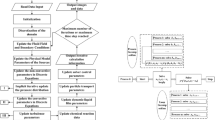Abstract
All new and retrofit installations of Halon 1301 total flooding fire protection systems in U.S. Navy shipboard machinery spaces require an acceptance discharge test. The primary reason for this testing is the verification of system design and performance (discharge time, initial concentration, maintenance of concentration, etc.). It is desirable to use a simulant instead of Halon 1301 in these tests in view of its contribution to stratospheric ozone depletion.
Two candidate simulants, sulfur hexafluoride (SF6) and chlorodifluoromethane (R-22 or Halon 121), were evaluated on the basis of flow through the piping networks of both modular and banked systems. Two modular systems, with differing fill densities, and six banked systems, varying in complexity from a two-nozzle balanced system to a four-nozzle unbalanced system, were used in this evaluation.
Sulfur hexafluoride was found to discharge at a similar rate to Halon 1301 while R-22 was found to discharge at a faster rate. The division of flow between branches in the piping networks were similar for both simulants and Halon 1301.
Together with previous work on leakage from an enclosure and initial mixing, these tests have shown that sulfur hexafluoride is an excellent simulant for Halon 1301 in acceptance discharge tests of total flooding fire protection systems. These conclusions will need to be confirmed in full-scale tests. The material presented here is extracted from a longer report that is available from the U.S. Naval Research Laboratory, Washington, DC 20375.
Similar content being viewed by others
References
Anderson, S.O., “Halons and the Stratospheric Ozone Issue,”Fire Journal, 81 (1987).
Anderson, S.O., “Halon Usage and Emissions,” overheads presented at NFPA fall meeting, 1987.
Taylor, G., “Achieving the Best Use of Halons,”Fire Journal, 81, 3 (1987).
DiNenno, P.J., & E.K. Budnick, “A Review of Discharge Testing of Halon 1301 Total Flooding Systems,” National Fire Protection Research Foundation, Batterymarch Park, Quincy, MA (1988).
DiNenno, P.J., E.W. Forssell, M.D. Starchville, & H.W. Carhart, “Evaluation of Halon 1301 Test Gas Simulants: Enclosure Leakage,”Fire Technology, 25, 1 (1989).
Carhart, H.W., J.T. Leonard, P.J. DiNenno, M.D. Starchville, E.W. Forssell, & J.T. Wong, “Tests of Halon 1301 Test Gas Simulants,” Memo Report, Naval Research Laboratory, Washington, DC, 1989.
Sax, N.I.,Dangerous Properties of Industrial Materials Sixth Edition, Van Nostrand Reinhold Company, New York, NY (1984).
Air Products and Chemicals, Inc., “SF6, An Applications and Technical Manual,” Air Products and Chemicals, Specialty Gas Department, Allentown, PA (1983).
“AccuDri SF6,” Allied Chemicals Technical Bulletin, Morristown, NJ (1987).
DuPont Company, “Halon 1301 Fire Extinguishant Product Information Library,” Vols 1 and 2, Wilmington, DE (1979).
Ember, L.R., P.L. Layman, W. Lepkowski, & P.S. Zurer, “The Changing Atmosphere,”Chemical & Engineering News, 64, 47 (1986).
E.I. du Pont de Nemours & Company, Inc., “Thermodynamic Properties of Freon 22 Refrigerant,” Wilmington, DE (1964).
E.I. du Pont De Nemours & Company, Inc., “Freon, Fluorocarbons, Properties and Applications,” Wilmington, DE (1985).
DiNenno, P.J., M.D. Starchville, E.W. Forssell, H.W. Carhart, & J.T. Leonard, “Initial Mixing Tests of Halon 1301 Test Gas Simulants,” Memo Report, Naval Research Laboratory, Washington, DC (1989).
National Fire Protection Association, “Standard on Halogenated Extinguishing Agent Systems—Halon 1301,” NFPA 12A-87, Batterymarch Park, Quincy, MA (1987).
Navy Sea Systems Command, “Halon 1301—Banked System,” Standard Drawing No. 803-5959326, Washington, D.C.
DiNenno, P.J., E.W. Forssell, M.D. Starchville, H.W. Carhart, & J.T. Leonard, “Discharge System Tests of Halon 1301 Test Gas Simulants,” Memo Report, Naval Research Laboratory, Washington, DC (1989).




